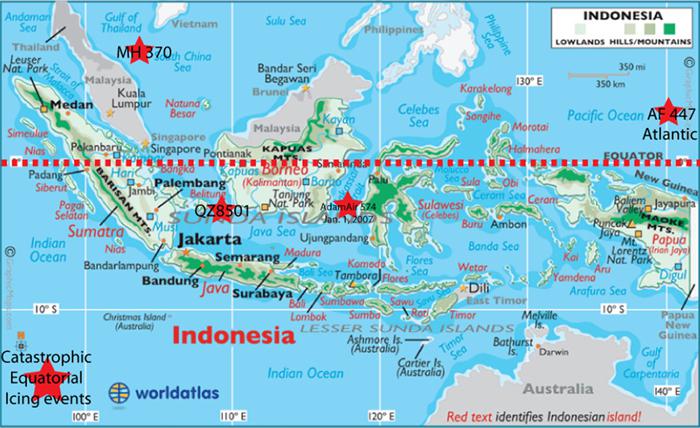Pilots Face Brick Wall-Like Icing Along Equator
A spate of commercial airliner crashes along the equator in Southeast Asian waters has taken the lives of several hundred passengers and cost hundreds of millions of dollars in aircraft equipment. A lack of concrete evidence of mechanical causes often results in a default decision of pilot error.
Yet, the aircraft may have been done in by an unavoidable freak atmospheric effect unique to the equatorial region. The airline flights involved include: Air France AF447, lost June 1, 2009, over the Atlantic near the equator; Adam Air DHI 574, January 1, 2007; Malaysia Airlines MH370, March 7, 2014; and most recently, AirAsia Flight QZ 8501, December 28, 2014.
These flights cited do not include other equatorial crashes or disappearances that involved only a few casualties, and for which in most cases there were no major investigations nor available detailed flight track information.
The only final decision of any possible cause was in the case of AF447, in which a report says ice crystals in vital pitot tubes generated false sensor information ultimately leading to pilot error. This conclusion was reached with the recovery of aircraft wreckage and the flight data recorder. The mystery surrounding missing Malaysia Airlines flight MH370 persists. Engine-to-satellite communications suggest the airliner flew for several hours off course after losing radar contact, ending up crashing in the ocean. No wreckage was found.
That all these events took place in equatorial regions causes Carl Gibson of the Scripps Institution of Oceanography to rely on earlier research. A widely recognized turbulence specialist, Gibson’s research, together with that of Mark A. Baker of the Applied Physics Laboratory/Johns Hopkins University, involves the behavior of air turbulence in equatorial regions.
The Coriolis effect is caused by the rotation of the Earth and the inertia of the mass experiencing the effect—in this case, water and air. On Earth, one way it manifests itself is in the circular motion of cyclonic storms—counterclockwise in the Northern Hemisphere, clockwise in the Southern Hemisphere. Because Coriolis forces vanish on the equator, the horizontal scale of turbulence extends from centimeter Kolmogorov scales to hundreds of kilometers. These effects vastly increase the amplitude and power of extreme turbulence events in equatorial regions.
The Earth completes one rotation per day, making the Coriolis force quite small. The resulting effects generally become noticeable only for motions occurring over large distances and long periods of time, such as large-scale movement of air in the atmosphere or water in the ocean. Gibson and Baker’s work (Journal of Physical Oceanography, October 1987) shows that the mean-to-mode ratio of turbulence dissipation rate on the equator is 30,000-to-1. This ratio probably has increased in recent years, according to Gibson.
As a result, a deadly combination of turbulence, waves and wind is causing aircraft crossing the equator to crash with increasing frequency because of higher ocean temperatures, according to Gibson. His research states that conditions along the equator cause extreme and rapid icing to occur in rare instances, even though most aircraft cruising at the same altitude pass through unharmed. The complex mechanism, termed Catastrophic Equatorial Icing, involves extreme maxima of stratified turbulence in natural fluids such as the ocean, atmosphere, astrophysical and cosmological flows. This icing phenomenon would explain the ice crystals clogging the pitot tubes in AF447.
A major oceanographic experiment in 2005 in Hawaii showed that the generic mechanism of stratified turbulent mixing involves mixing chimneys powered by fossil turbulence waves in the vertical direction. Combining extreme turbulence events of the equator with a mixing chimney of supercooled water vapor provides the equivalent of a brick wall to aircraft cruising at altitude. Within about four minutes, all pitot tubes and control surfaces would ice over, and the doomed plane ultimately would hit the water. Nothing can be done by any pilot once this condition is established. The loss of the aircraft is not pilot error.





Comment
The latest crash due to CEI
The latest crash due to CEI (catastrophic equatorial icing) is Lion Air flight 610 October 29 2018 killing 189 people. One symptom of CEI is a sudden increase in altitude since icing forms first on the tail. The new Boeing 737 MAX avionics MCAS only accelerates the disaster.
Since the Keeler article in
Since the Keeler article in SIGNAL was published, conclusive proof that MH370 crashed due to CEI has become available (journalofcosmology.com volume 26 etc.).
Catastrophic Equatorial Icing
Catastrophic Equatorial Icing events appear to be increasing in frequency due to global warming, and are now the major cause of deaths in commercial airlines.
Another CEI crash killing
Another CEI crash killing everyone aboard is a Boeing Ethiopian Air Flight near Nairobi. Boeing planes
have been grounded for months by the FAA at a cost of about a Billion $ a month. This money should be going to studies of the means needed to avoid CEI events. Perhaps Boeing should pay for such studies, as well as a preliminary study to recover the MH370 plane from the point where it went off radar and is almost certainly where it remains on the bottom of the South China Sea journalofcosmology.com and CEI.ucsd.edu, cgibson@ucsd.edu
Comments